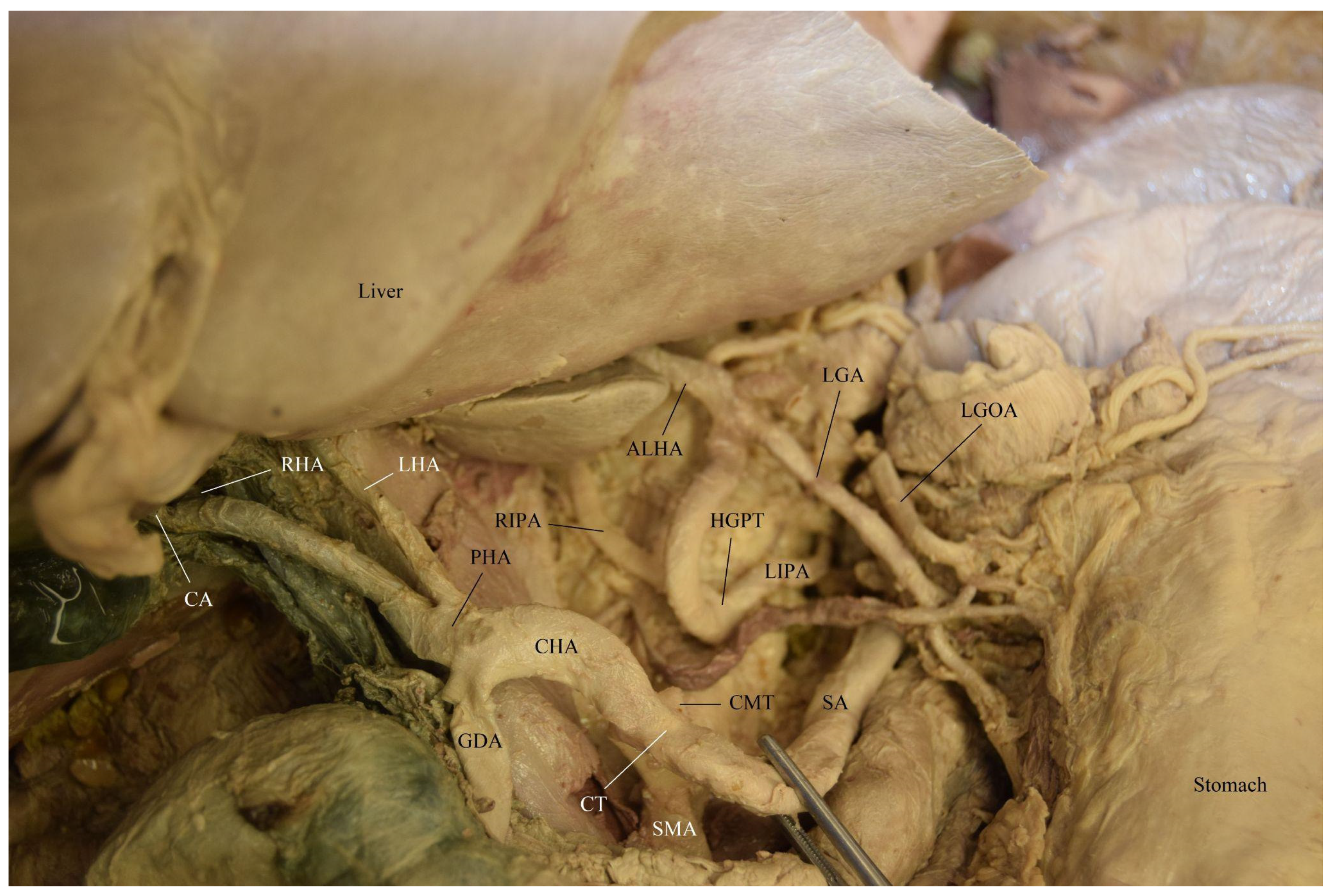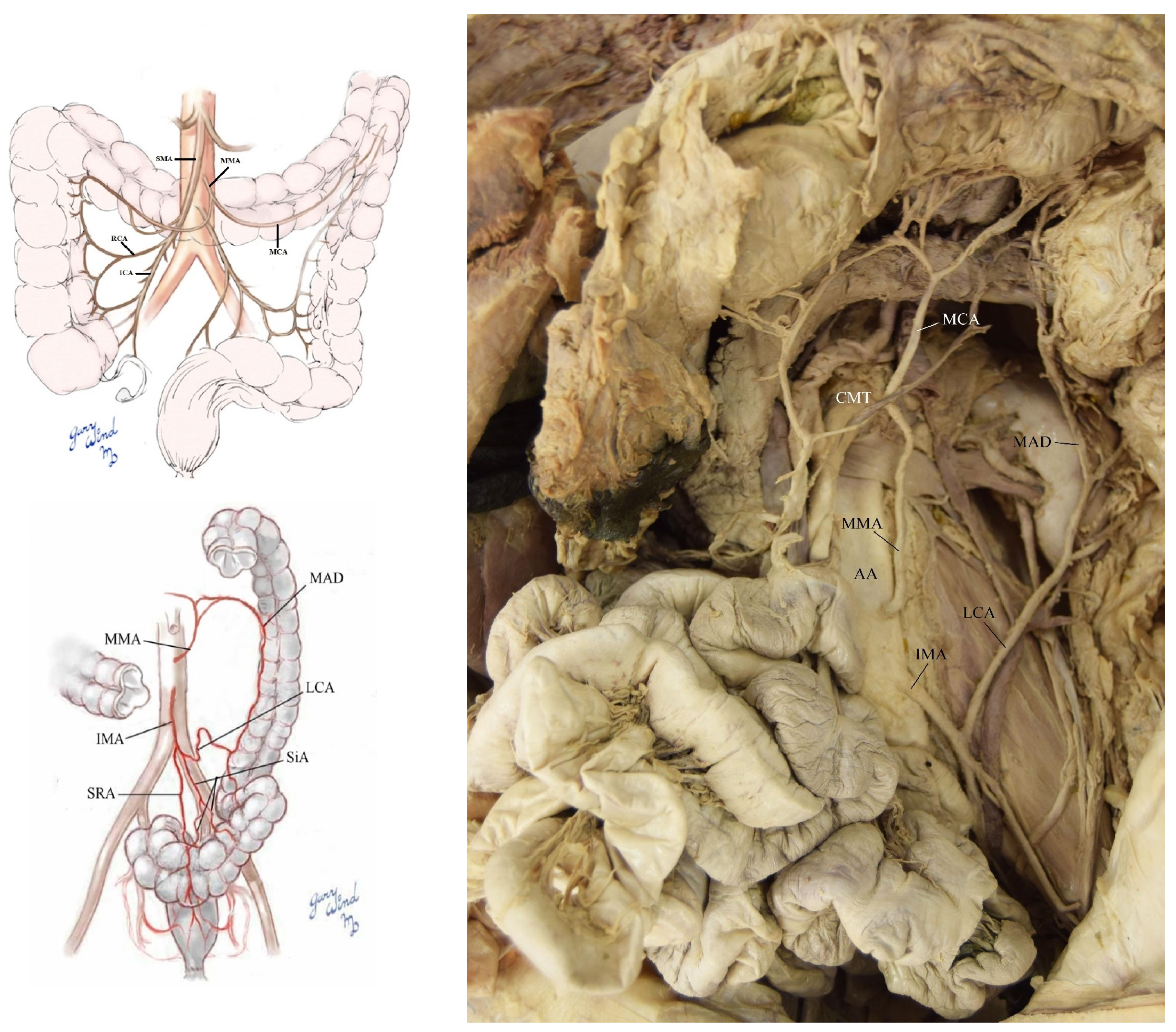A Hepatogastrophrenic Trunk, Celiacomesenteric Trunk, and a Middle Mesenteric Artery in a 68-Year-Old White Male Donor
Abstract
:1. Introduction
2. Case Description
3. Discussion
3.1. Celiacomesenteric Trunk (CMT)
3.2. Hepatogastrophrenic Trunk (HGPT)
3.3. Accessory Left Hepatic Artery (ALHA)
3.4. Middle Mesenteric Artery (MMA)
3.5. Embryonic Development
3.6. Clinical Significance
3.6.1. CMT
3.6.2. HGPT
3.6.3. ALHA
3.6.4. MMA
3.6.5. Other
4. Conclusions
Author Contributions
Funding
Data Availability Statement
Acknowledgments
Conflicts of Interest
Disclaimer
Abbreviations
References
- Varma, K.S.; Pamidi, N.; Vollala, V.R. Common celiacomesenteric trunk: A rare anatomic variation. J. Vasc. Bras. 2009, 8, 271–273. [Google Scholar] [CrossRef]
- Sahni, D.; Aggarwal, A.; Gupta, T.; Kaur, H.; Gupta, R.; Chawla, K.; Saini, N.; Garg, S.; Singla, A.; Deep, A.; et al. Abdominal Aorta. In Bergman’s Comprehensive Encyclopedia of Human Anatomic Variation, 1st ed.; Tubbs, S., Shoja, M.M., Loukas, M., Eds.; John & Wiley & Sons, Inc.: Hoboken, NJ, USA, 2016; pp. 619–681. [Google Scholar]
- VanDamme, J.P.; Bonte, J. Vascular Anatomy in Abdominal Surgery; Thieme Verlag: London, UK, 1990; pp. 1–141. [Google Scholar]
- Bergman, R.A.; Thompson, S.A.; Afifi, A.K.; Saddeh, F.A. Compendium of Human Anatomic Variation: Text, Atlas, and World Literature; Urban & Schwarzenberg: Munich, Germany, 1988. [Google Scholar]
- Michels, N.A. The anatomical variation of the arterial pancreatic, bladder, bile duct, liver, pancreas and parts of small and large intestine. J. Int. Surg. 1962, 18, 13–40. [Google Scholar]
- Michel, N.A. Blood Supply and Anatomy of the Upper Abdominal Organs, with a Descriptive Atlas; Observation on the Blood Supply of Liver and Gall Bladder; Lippincott: Philadelphia, PA, USA, 1955; pp. 64–69. [Google Scholar]
- Olewnik, Ł.; Waśniewska, A.; Polguj, M.; Topol, M. Rare combined variations of renal, suprarenal, phrenic and accessory hepatic arteries. Surg. Radiol. Anat. 2018, 40, 743–748. [Google Scholar] [CrossRef] [PubMed] [Green Version]
- Poynter, C.W.M. Congenital Anomalies of the Arteries and Veins of the Human Body with Bibliography; The University Studies of the University of Nebraska: Lincoln, NE, USA, 1922; Volume 22, pp. 1–106. [Google Scholar]
- Hemanth, K.; Garg, S.; Yadav, T.D.; Sahni, D. Hepato-gastro-phrenic trunk and hepato-spleno-mesenteric trunk: A rare anatomic variation. Trop. Gastroenterol. 2011, 32, 56–59. [Google Scholar]
- Adachi, B. Das Arteriensystem der Japaner; Kenkyusha Press: Kyoto, Japan, 1928; Volume 2, pp. 18–71. [Google Scholar]
- Haller, A. Icon Anatomical in Quibus Aliquae Partes Corporis Humani Delineatae Proponuntur et Arteriarum Potissimum Historia Continetur; Vandenhoeck: Gottingen, Germany, 1756; Volume III, p. 270. [Google Scholar]
- Gielecki, J.; Żurada, A.; Sonpal, N.; Jabłońska, B. The clinical relevance of coeliac trunk variations. Folia Morphol. 2005, 64, 123–129. [Google Scholar]
- Ramesh Babu, C.S.; Joshi, S.; Gupta, K.K.; Gupta, O.P. Celiacomesenteric trunk and its variants a multidetector row computed tomographic study. J. Anat. Soc. India 2015, 64, 32–41. [Google Scholar] [CrossRef]
- Hiatt, J.R.; Gabbay, J.; Busuttil, R.W. Surgical anatomy of the hepatic arteries in 1000 cases. Ann. Surg. 1994, 220, 50–52. [Google Scholar] [CrossRef]
- Polguj, M.; Gabryniak, T.; Topol, M. The right accessory hepatic artery; a case report and review of the literature. Surg. Radiol. Anat. 2010, 32, 175–179. [Google Scholar] [CrossRef]
- Benton, R.S.; Cotter, W.B. A hitherto undocumented variation of theinferior mesenteric artery in man. Anat. Rec. 1963, 145, 171–173. [Google Scholar] [CrossRef]
- Lawdahl, R.B.; Keller, F.S. The middle colic artery. Radiology 1987, 165, 371–372. [Google Scholar] [CrossRef]
- Yoshida, T.; Suzuki, S.; Sato, T. Middle mesenteric artery: An anom-alous origin of a middle colic artery. Surg. Radiol. Anat. 1993, 15, 361–363. [Google Scholar] [CrossRef]
- LeQuire, M.H.; Sorge, D.G.; Brantley, S.D. The middle mesenteric artery: An unusual source for colonic hemorrhage. J. Vasc. Interv. Radiol. 1991, 2, 141–145. [Google Scholar] [CrossRef]
- Milnerowicz, S.; Milnerowicz, A.; Taboła, R. A middle mesenteric artery. Surg. Radiol. Anat. 2012, 34, 973–975. [Google Scholar] [CrossRef] [PubMed] [Green Version]
- Tang, W.; Shi, J.; Kuang, L.Q.; Tang, S.Y.; Wang, Y. Celiomesenteric trunk: New classification based on multidetector computed tomography angiographic findings and probable embryological mechanisms. World J. Clin. Cases 2019, 7, 3980–3989. [Google Scholar] [CrossRef] [PubMed]
- Katagiri, H.; Ichimura, K.; Sakai, T. A case of celiacomesenteric trunk with some other arterial anomalies in a Japanese woman. Anat. Sci. Int. 2007, 82, 53–58. [Google Scholar] [CrossRef]
- Lovisetto, F.; De Lorenzi, G.F.; Stancampiano, P.; Corradini, C.; De Cesare, F.; Geraci, O.; Manzi, M.; Arceci, F. Thrombosis of celiacomesenteric trunk: Report of a case. World J. Gastroenterol. 2012, 18, 3917. [Google Scholar] [CrossRef]
- Hogea, B.G.; Rusu, M.C.; Jianu, A.M.; Manta, B.A.; Ilie, A.C. Rare Anatomic Variation: The Hepatosplenomesentericophrenic Trunk. Medicina 2021, 57, 170. [Google Scholar] [CrossRef]
- Aslaner, R.; Pekcevik, Y.; Sahin, H.; Toka, O. Variations in the origin of inferior phrenic arteries and their relationship to celiac axis variations on CT angiography. Korean J. Radiol. 2017, 18, 336–344. [Google Scholar] [CrossRef] [Green Version]
- Abdullah, S.S.; Mabrut, J.-Y.; Garbit, V.; De La Roche, E.; Olagne, E.; Rode, A.; Morin, A.; Berthezene, Y.; Baulieux, J.; Ducerf, C. Anatomical variations of the hepatic artery: Study of 932 cases in liver transplantation. Surg. Radiol. Anat. 2006, 28, 468–473. [Google Scholar] [CrossRef]
- Hardy, K.J.; Jones, R.M. Hepatic artery anatomy in relation to reconstruction in liver transplantation: Some unusual variations. Aust. N. Z. J. Surg. 1994, 64, 437–440. [Google Scholar] [CrossRef]
- Pai, R.S.; Hunnargi, A.S.; Srinivasan, M. Accessory left hepatic artery arising from common hepatic artery. Indian J. Surg. 2008, 70, 80–82. [Google Scholar] [CrossRef] [PubMed] [Green Version]
- Noussios, G.; Dimitriou, I.; Chatzis, I.; Katsourakis, A. The Main Anatomic Variations of the Hepatic Artery and Their Importance in Surgical Practice: Review of the Literature. J. Clin. Med. Res. 2017, 9, 248–252. [Google Scholar] [CrossRef] [PubMed] [Green Version]
- Michaels, N.A.; Siddaharth, P.; Kornbilth, P.L.; Parke, W.W. The variant blood supply to the small and large intestine: Its import in regional resections. J. Int. Coll. Surg. 1963, 26, 843–891. [Google Scholar]
- Abdel-Aal, A.K.; Moustafa, A.S. Incidentally Discovered Middle Mesenteric Artery in A Renal Donor. J. Radiol. Case Rep. 2015, 9, 12–20. [Google Scholar] [CrossRef] [PubMed]
- Alam, W.; Kamareddine, M.H.; Geahchan, A.; Ghosn, Y.; Feghaly, M.; Chamseddine, A.; Bou Khalil, R.; Farhat, S. Celiacomesenteric trunk associated with superior mesenteric artery aneurysm: A case report and review of literature. SAGE Open Med. Case Rep. 2020, 8, 2050313X20938243. [Google Scholar] [CrossRef] [PubMed]
- Latona, J.A.; Lamb, K.M.; Pucci, M.J.; Maley, W.R.; Yeo, C.J. Modified Appleby Procedure with Arterial Reconstruction for Locally Advanced Pancreatic Adenocarcinoma: A Literature Review and Report of Three Unusual Cases. J. Gastrointest. Surg. 2016, 20, 300–306. [Google Scholar] [CrossRef]
- Loukas, M.; Hullett, J.; Wagner, T. Clinical anatomy of the inferior phrenic artery. Clin. Anat. 2005, 18, 357–365. [Google Scholar] [CrossRef]
- Özcan, G.; Kocabiyik, N.; Kale, A.; Bülent, Y.; Hasan, O. Multivariations of the Left Gastric Artery: A Case Report. Trak. Univ. Tip Fak. Derg. 2010, 27, 420. [Google Scholar] [CrossRef]
- Douard, R.; Chevallier, J.M.; Delmas, V.; Cugnenc, P.H. Clinical interest of digestive arterial trunk anastomoses. Surg. Radiol. Anat. 2006, 28, 219–227. [Google Scholar] [CrossRef]
- Ailawadi, G.; Cowles, R.A.; Stanley, J.C.; Eliason, J.L.; Williams, D.M.; Colletti, L.M.; Henke, P.K.; Upchurch, G.R., Jr. Common celiacomesenteric trunk: Aneurysmal and occlusive disease. J. Vasc. Surg. 2004, 40, 1040–1043. [Google Scholar] [CrossRef] [Green Version]
- Boukoucha, M.; Yahmadi, A.; Znaidi, H.; Ben Khelifa, R.; Daghfous, A. Spontaneous celiacomesenteric trunk dissection: Case report. Int. J. Surg. Case Rep. 2020, 71, 128–131. [Google Scholar] [CrossRef] [PubMed]




Publisher’s Note: MDPI stays neutral with regard to jurisdictional claims in published maps and institutional affiliations. |
© 2022 by the authors. Licensee MDPI, Basel, Switzerland. This article is an open access article distributed under the terms and conditions of the Creative Commons Attribution (CC BY) license (https://creativecommons.org/licenses/by/4.0/).
Share and Cite
Sheridan, A.; Reynolds, E.; Maynes, E.; Wind, G.; Leighton, M.X.; Granite, G. A Hepatogastrophrenic Trunk, Celiacomesenteric Trunk, and a Middle Mesenteric Artery in a 68-Year-Old White Male Donor. Diagnostics 2022, 12, 1597. https://doi.org/10.3390/diagnostics12071597
Sheridan A, Reynolds E, Maynes E, Wind G, Leighton MX, Granite G. A Hepatogastrophrenic Trunk, Celiacomesenteric Trunk, and a Middle Mesenteric Artery in a 68-Year-Old White Male Donor. Diagnostics. 2022; 12(7):1597. https://doi.org/10.3390/diagnostics12071597
Chicago/Turabian StyleSheridan, Ariana, Elizabeth Reynolds, Elizabeth Maynes, Gary Wind, Maria Ximena Leighton, and Guinevere Granite. 2022. "A Hepatogastrophrenic Trunk, Celiacomesenteric Trunk, and a Middle Mesenteric Artery in a 68-Year-Old White Male Donor" Diagnostics 12, no. 7: 1597. https://doi.org/10.3390/diagnostics12071597






